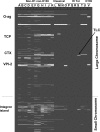Genomic analysis of the Mozambique strain of Vibrio cholerae O1 reveals the origin of El Tor strains carrying classical CTX prophage
- PMID: 17360342
- PMCID: PMC1829278
- DOI: 10.1073/pnas.0700365104
Genomic analysis of the Mozambique strain of Vibrio cholerae O1 reveals the origin of El Tor strains carrying classical CTX prophage
Abstract
Cholera outbreaks in subSaharan African countries are caused by strains of the El Tor biotype of toxigenic Vibrio cholerae O1. The El Tor biotype is the causative agent of the current seventh cholera pandemic, whereas the classical biotype, which was associated with the sixth pandemic, is now extinct. Besides other genetic differences the CTX prophages encoding cholera toxin in the two biotypes of V. cholerae O1 have distinct repressor (rstR) genes. However, recent incidences of cholera in Mozambique were caused by an El Tor biotype V. cholerae O1 strain that, unusually, carries a classical type (CTX(class)) prophage. We conducted genomic analysis of the Mozambique strain and its CTX prophage together with chromosomal phage integration sites to understand the origin of this atypical strain and its evolutionary relationship with the true seventh pandemic strain. These analyses showed that the Mozambique strain carries two copies of CTX(class) prophage located on the small chromosome in a tandem array that allows excision of the prophage, but the excised phage genome was deficient in replication and did not produce CTX(class) virion. Comparative genomic microarray analysis revealed that the strain shares most of its genes with the typical El Tor strain N16961 but did not carry the TLC gene cluster, and RS1 sequence, adjacent to the CTX prophage. Our data are consistent with the Mozambique strain's having evolved from a progenitor similar to the seventh pandemic strain, involving multiple recombination events and suggest a model for origination of El Tor strains carrying the classical CTX prophage.
Conflict of interest statement
The authors declare no conflict of interest.
Figures




References
-
- Waldor MK, Mekalanos JJ. Science. 1996;272:1910–1914. 37. - PubMed
Publication types
MeSH terms
Substances
Grants and funding
LinkOut - more resources
Full Text Sources
Other Literature Sources

